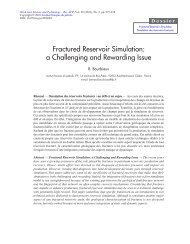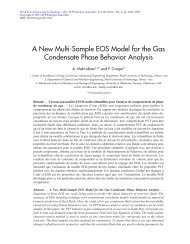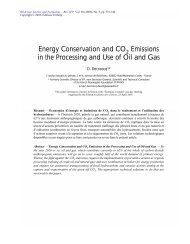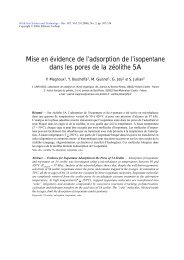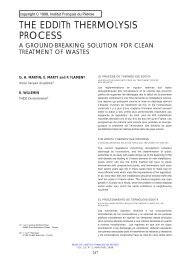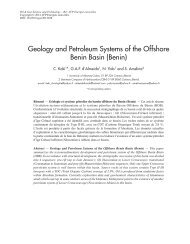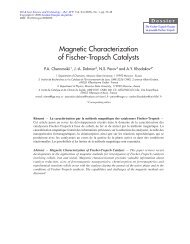PDF (1.130 MB) - Oil & Gas Science and Technology - IFP Energies ...
PDF (1.130 MB) - Oil & Gas Science and Technology - IFP Energies ...
PDF (1.130 MB) - Oil & Gas Science and Technology - IFP Energies ...
- No tags were found...
Create successful ePaper yourself
Turn your PDF publications into a flip-book with our unique Google optimized e-Paper software.
<strong>Oil</strong> & <strong>Gas</strong> <strong>Science</strong> <strong>and</strong> <strong>Technology</strong> – Rev. <strong>IFP</strong> <strong>Energies</strong> nouvelles, Vol. 65 (2010), No. 6, pp. 883-892Copyright © 2010, <strong>IFP</strong> <strong>Energies</strong> nouvellesDOI: 10.2516/ogst/2009069A Comparison of Effects of Ambient Pressureon the Atomization Performance ofSoybean <strong>Oil</strong> Methyl Ester <strong>and</strong> Dimethyl Ether SpraysH.J. Kim 1 , S.H. Park 2 , M.S. Chon 3 <strong>and</strong> C.S. Lee 1*1 Department of Mechanical Engineering, Hanyang University, 17 Haengdang-dong, Seongdong-gu, Seoul 133-791 - Korea2 Graduate School of Hanyang University, 17 Haengdang-dong, Seoungdong-gu, Seoul 133-791 - Korea3 Department of Energy System Engineering, Chungju National University, Chungju - Koreae-mail: jun<strong>and</strong>jin@hanyang.ac.kr - psh7836@hanyang.ac.kr - mschon@cjnu.ac.kr - cslee@hanyang.ac.kr* Corresponding authorRésumé — Comparaison des effets de la pression ambiante sur l’atomisation en “spray” demethylester d’huile de soja et de dimethyléther — Le but de cette étude est l'investigationexpérimentale de l'effet de diverses pressions ambiantes sur les caractéristiques des sprays (issus d'unsystème "common rail") de methylester d'huile de soja (SME) et de dimethyléther (DME). La pressionambiante dépend de la chambre et sa valeur la plus haute peut monter jusqu'à 4 MPa. Pour comparer ledéveloppement de spray et la caractéristique d'atomisation, des images de spray de SME et DME àdifférentes pression ambiantes sont obtenues avec une caméra à haute vitesse à deux lampes de métalhalide. Les caractéristiques du spray, comme la pénétration, la distance radiale maximale et le diamètrede spray, sont mesurées et analysées. De plus, le diamètre de Sauter (SMD) des deux carburants àdifférentes pressions est mesuré. On a constaté que, dans les mêmes conditions, la distance depénétration du spray de SME est supérieure à celle du spray de DME. La pénétration axiale, la distanceradiale maximale et le diamètre du spray décroissent qu<strong>and</strong> la pression ambiante croît. Qu<strong>and</strong> la pressionambiante croît, le SMD décroît et le spray de DME montre plus d'atomisation que celui de SME.Abstract — A Comparison of Effects of Ambient Pressure on the Atomization Performance ofSoybean <strong>Oil</strong> Methyl Ester <strong>and</strong> Dimethyl Ether Sprays — The purpose of this study is the experimentalinvestigation of Soybean oil Methyl Ester (SME) <strong>and</strong> DiMethyl Ether (DME) spray characteristicsinjected through the common-rail injection system under various ambient pressures. A high pressurechamber that can be pressurized up to 4 MPa was utilized for a change of ambient pressure. In order tocompare the spray development <strong>and</strong> atomization characteristics, the images of SME <strong>and</strong> DME wereobtained by using a high speed camera with two metal halide lamps under various ambient pressures inthe spray chamber. From these spray images, the spray characteristics such as the spray penetrationfrom the nozzle tip, maximum radial distance, <strong>and</strong> spray diameter were measured <strong>and</strong> analyzed. Inaddition, the Sauter Mean Diameter (SMD) of two fuels under ambient pressure was analyzed using thedroplet measuring system. It was revealed that the axial distance of spray from the nozzle tip of the SMEspray is longer than that of DME spray under same injection condition. The axial penetration, maximumradial distance, <strong>and</strong> spray diameter decreased when the ambient pressure in the chamber increased. Asthe ambient pressure increased, the SMD decreased <strong>and</strong> the DME spray showed a superior atomizationperformance compared to the SME spray.
884<strong>Oil</strong> & <strong>Gas</strong> <strong>Science</strong> <strong>and</strong> <strong>Technology</strong> – Rev. <strong>IFP</strong> <strong>Energies</strong> nouvelles, Vol. 65 (2010), No. 6INTRODUCTIONThe fuel spray characteristics assumed different aspectsaccording to the various injection <strong>and</strong> ambient conditionssuch as injection pressure, energizing duration, injectionmass, spray cone angle, ambient pressure, <strong>and</strong> ambient temperaturein the combustion chamber. Particularly, in a HighSpeed Direct Injection (HSDI) diesel engine, spray characteristicsare greatly influenced by the ambient conditions in thecylinder. In addition, the atomization <strong>and</strong> spray characteristicsof fuel were directly influenced on the combustion performance<strong>and</strong> emission characteristics. Many studies on thediesel spray, SME <strong>and</strong> DME spray characteristics under variousambient conditions of high pressure <strong>and</strong> temperaturehave been conducted by researchers.Paryi et al. (1996) conducted the investigation on theevolution of diesel spray under a high gas density by usinghigh speed photography <strong>and</strong> phase Doppler anemometry.They reported that a spray cone angle was more influencedby a gas density than the injection condition. The experimental<strong>and</strong> numerical studies on the diesel spray penetration at ahigh pressure <strong>and</strong> temperature under various injection pressureswere carried out by Abdelghaffar et al. (2007). Theysuggested that the diesel spray penetration length decreasedwith the increasing of an in-cylinder pressure, <strong>and</strong> tip penetrationdecreased due to the increase of vaporization rate atthe high ambient gas temperature. Roisman et al. (2007)studied the experimental <strong>and</strong> theoretical investigations on thediesel spray penetration <strong>and</strong> cone angle at the ambient pressurein the chamber. Their work suggested that the spray penetrationwas determined by two major factors such as inertiaof liquid/air mixture in the steady conical spray region <strong>and</strong>the particular conditions near the leading spray edge. Theresearch on the vapor/liquid phase penetration <strong>and</strong> spray coneangle under ambient condition equivalent to an actual enginecylinder was conducted by Yamashita et al. (2007). Theyfound that the vapor phase penetration increased but the penetrationof rich mixture becomes shorter when the injectionpressure increased.Besides being the diesel spray characteristics as the ambientcondition, investigations on alternative fuels for the dieselfuel have been actively advanced to solve the environmentalpollution. Among many alternative fuels, Soybean oil MethylEster (SME) <strong>and</strong> DiMethyl Ether (DME), including a largeamount of the oxygen molecular, can be produced with lowerexhaust emissions, such as soot <strong>and</strong> particulate matter, comparedto diesel fuel. These fuels are suitable for the compressionignition engine due to a high cetane number. Therefore,the SME <strong>and</strong> DME fuel are in the spotlight of representativealternative fuel instead of the diesel fuel.However, the SME fuel has demerits such as the disturbancefactor of atomization by a high viscosity, a problem in a coldstartdue to crystallizing property, <strong>and</strong> the acidificationduring long-term storage. In the case of DME fuel, pressureis applied to convert the liquid phase at the atmosphericcondition <strong>and</strong> can leak in the fuel supply system by lowviscosity <strong>and</strong> bad lubrication (Sorenson et al., 1998). Also,the modification of the fuel supply system needs to directlyapply to the diesel engine due to the melting property byreaction with rubber. In order to solve these problems, morestudies are needed to clarify the spray characteristics of SME<strong>and</strong> DME due to the different fuel properties.Fang et al. (2008) investigated that the experimental spray<strong>and</strong> combustion characteristics of diesel, biodiesel, <strong>and</strong>diesel-biodiesel blended fuels were analyzed by using visualizationsystem in a small-bore HSDI diesel engine. Theyreported that the longer penetration <strong>and</strong> ignition delay wereobserved with more biodiesel content. Lee et al. (2005) suggestedthat the atomization performance fell off <strong>and</strong> the peakcombustion pressure increased as the mixing ratio ofbiodiesel increased in their study on the atomization <strong>and</strong>combustion characteristics according to the mixing ratio ofbiodiesel blended fuel. The experimental investigations onthe spray structure of diesel fuel <strong>and</strong> oxygenated fuel includingDiMethyl Ether by using PIV method were studied byWu et al. (2006). Kim et al. (2008a) carried out the comparisonbetween the experimental <strong>and</strong> numerical study on thespray characteristics of biodiesel, DiMethyl Ether, <strong>and</strong>biodiesel-ethanol blended fuels. Also, they experimentally<strong>and</strong> numerically analyzed the spray characteristics of diesel<strong>and</strong> DME fuels under the high ambient pressure in differentchamber shapes (Kim et al., 2008b). Sidu et al. (2001) <strong>and</strong> Liet al. (2001) studied the experimental study on the spray <strong>and</strong>evaporation characteristics of DME fuel in the constant volumecombustion chamber. They revealed that the spray penetration<strong>and</strong> the spray angle decreased <strong>and</strong> increased withincreasing ambient density, respectively. In addition, DMEspray were much faster the evaporating process than dieselspray at high ambient temperature. However, the high viscosityof biodiesel fuel makes the needle lift slower. Also, thehigh density <strong>and</strong> bulk modulus of biodiesel fuel led to thehigher injection velocity, longer penetration <strong>and</strong> narrowercone angle than the diesel fuel (Pogorevc et al., 2008;Desantes et al., 2009). The spray tip penetration of biodieselincreased <strong>and</strong> its spray cone angle decreased when the ambientpressure became lower. Also, the penetration moreaffected by the ambient pressure than the injection pressure(He et al., 2008).Detailed information on the spray <strong>and</strong> atomizationcharacteristics of DME <strong>and</strong> biodiesel fuel under the ambientcondition in the constant volume chamber is limited <strong>and</strong> ithas many uncertainties due to the insufficiency of analysis onthe comparison between the overall spray characteristics ofDME <strong>and</strong> biodiesel. Therefore, in this study, the experimentalinvestigations were conducted by using high speed camera<strong>and</strong> droplet measuring systems for the analysis of SME<strong>and</strong> DME spray characteristics according to the injectionconditions under various ambient pressures in the chamber.
886<strong>Oil</strong> & <strong>Gas</strong> <strong>Science</strong> <strong>and</strong> <strong>Technology</strong> – Rev. <strong>IFP</strong> <strong>Energies</strong> nouvelles, Vol. 65 (2010), No. 6Density of liquid phase (kg/m 3 )1000950900850800750700650600010Density Viscosity20FuelSME [Yoon et al. (2008)]DME [Teng et al. (2004)]30 40 50 60Temperature (°C)70121086420.150.100.050.00Figure 2Density <strong>and</strong> viscosity of test fuels according to variation intemperature.Viscosity of liquid phase (cP)the diameter sub-range was set from 2 μm to 80 μm, <strong>and</strong>approximately 5000 droplets were averaged at each measuringpoint. Visualization <strong>and</strong> droplet measuring experimentswere conducted under various ambient pressures of 1, 10,20 bar, <strong>and</strong> injection duration of 1.2 ms. An ambient gaspressure was controlled by nitrogen gas. Detailed experimentalconditions were illustrated in Table 2.Injection pressureAmbient pressureEnergizing durationAmbient temperatureInjection pressureTABLE 2Experimental conditionsSpray visualizationDroplet measurement500, 700 bar1, 10, 20 bar1.2 ms293 K700 barAmbient pressure1, 10, 20 barIn this work, the injection characteristics <strong>and</strong> spray behaviorunder the various ambient pressures were investigated byusing Soybean oil Methyl Ester <strong>and</strong> DiMethyl Ether. Theproperties of SME fuel were based on the experimentalresults investigated by Yoon et al. (2008). Also, Teng et al.(2001-2004) <strong>and</strong> Teng <strong>and</strong> McC<strong>and</strong>less (2005) carried outthe numerical investigations of the thermodynamic characteristicsof the liquefied DME on the basis of developed equationsfor the commonly used thermo-physical properties.Figure 2 shows the viscosity <strong>and</strong> density of SME <strong>and</strong> DMEfuel at the liquid phase according to the variation in temperature.As the temperature increased, a density <strong>and</strong> viscosity ofboth fuels decreased. In addition, the density of SME fuel ishigher than that of DME fuel <strong>and</strong> DME fuel has very lowviscosity in comparison with SME fuel.For investigating the injection characteristics, four hundredcontinuous injections were averaged for a test case accordingto the injection duration. Also, the injection delay was calculatedby the time from the input of an electric signal at theinjector till the start of the injection at the nozzle exit fromspray images. Macroscopic spray characteristics, whichobtained from a high speed camera, were analyzed fromspray images of side view <strong>and</strong> bottom view type. The spraycharacteristics such as the axial distance from the nozzle tip,the maximum radial distance, <strong>and</strong> spray diameter in the bottomview were defined as illustrated in Figure 3. For investigatingthe microscopic spray characteristics, measurementpoints were selected at 10 mm intervals from a distance of20 mm at the nozzle tip to 60 mm toward the axial direction.After the ending of the measurement at one point, theremaining gas <strong>and</strong> fuel in the chamber were exhausted by thecompressed nitrogen gas for the accurate experiment. Also,Energizing durationAmbient temperatureSide viewPenetration from the nozzle tip (mm)Maximum radialDistance (mm)2 RESULTS AND DISCUSSIONBottom viewSpray diameter(mm)1.2 ms293 KMeasurementpointsNozzletipAxialdirectionFigure 3Definitions of spray characteristics <strong>and</strong> measurement points.20 mm10mm60 mm2.1 Injection Characteristics of SME <strong>and</strong> DME SprayThe injection quantity according to the energizing duration<strong>and</strong> the injection delay were measured in order to analyze the
HJ Kim et al. / A Comparison of Effects of Ambient Pressure on the Atomization Performanceof Soybean <strong>Oil</strong> Methyl Ester <strong>and</strong> Dimethyl Ether Sprays887Injection quantity (mg)a)Injection delay (ms)b)Injection velocity at the nozzle exit (m/s)c)353025201510500.360.340.320.300.280.261000800600400200000.6Figure 4SME500 barDME500 bar700 bar0.8 1.0 1.2 1.4Energizing duration (ms)SME700 bar500 barInjection pressureBiodiesel (500 bar): 14.1 mgDME (500 bar): 12.5 mgBiodiesel (700 bar): 19.7 mgDME (700 bar): 15.0 mgDME700 bar1.6t eng = 1.0 ms0.3 0.6 0.9 1.2 1.5Time after the start of energizing (ms)Injection quantity, delay <strong>and</strong> velocity according to the twofuels <strong>and</strong> pressure. a) injection quantity; b) injection delay;c) injection velocity (energizing duration = 1.0 ms).injection characteristics of SME <strong>and</strong> DME spray. Figure 4ashows the injection quantity of SME <strong>and</strong> DME spray at 500<strong>and</strong> 700 bar of injection pressure according to the energizingduration. As the injection duration increased, the injectionquantity of two fuels shows a linear increase curve. The gapof injection quantity between the 500 bar <strong>and</strong> 700 bar ofinjection pressure showed a similar value regardless of theinjection duration. In addition, it is known that the injectionquantity of SME spray is larger than that of DME spray at allinjection conditions because the DME fuel has a lower densitythan the SME fuel as can be seen in Figure 2.The injection delay of SME <strong>and</strong> DME spray according tothe injection pressure was illustrated in Figure 4b. The injectiondelay defined the time from the input of electric signal atthe injector till the start of the injection at the nozzle exit. Ascan be seen in Figure 4b, the injection delay of SME spray atthe 500 bar of injection pressure is longer than that of DMEspray because of the friction between the fuel <strong>and</strong> nozzle inthe injector by a high viscosity of SME fuel. However, theinjection delay of SME <strong>and</strong> DME spray at the injection pressureof 700 bar shows an almost equal value because it canbe guessed that the effect of fuel viscosity is lower than thatof the faster velocity by a high injection pressure.Figure 4c shows the injection velocities of the two fuels<strong>and</strong> injection pressure according to the elapsed time after thestart of the energizing. On the basis of the Bosch method(Bosch, 1966), the injection rates were measured by an injectionrate measuring system. In addition, the injection velocitiesof two fuels were calculated by the obtained informationfrom the injected mass <strong>and</strong> injection rate. As the injectionpressure increased, it tends to increase the injection velocitiesof two fuels. Also, the biodiesel fuel has higher peak of injectionvelocity than the DME fuel regardless of injection pressurebut the DME fuel early jetted out of nozzle hole exitcompared to the biodiesel fuel due to the low DME fuel viscosity.The injection duration increased with increasing injectionpressure <strong>and</strong> biodiesel fuel showed a short injectionperiod compared to DME fuel.2.2 Development Process of SME <strong>and</strong> DME SprayThe development processes of SME <strong>and</strong> DME spray wereanalyzed from spray images obtained by high speed camera.Figure 5 shows the SME <strong>and</strong> DME spray images of 0.6 ms<strong>and</strong> 1.2 ms after the start of the injection according to theambient pressure. As can be seen in Figure 5a, the spraydevelopment of two fuels in the side view was slow progresswhen the ambient pressure increased. This reason is the preventionof spray progress toward the axial <strong>and</strong> radial directiondue to a high drag force caused by an increase of ambientpressure. In the case of spray images at 0.6 ms after thestart of the injection, the development of DME spray is fasterthan that of SME spray, but the SME spray at 1.2 ms developedquickly compared to the DME spray. For this reason, it
888<strong>Oil</strong> & <strong>Gas</strong> <strong>Science</strong> <strong>and</strong> <strong>Technology</strong> – Rev. <strong>IFP</strong> <strong>Energies</strong> nouvelles, Vol. 65 (2010), No. 60.6 ms1.2 msFuelAmbient pressurea) P inj = 500 bar0.6 msFuelSideviewBottomviewSideviewBottomviewAmbient pressureSideviewBottomviewSMEDME1bar 10 bar 20 bar 1bar 10 bar 20 barSMEDME1bar 10 bar 20 bar 1bar 10 bar 20 barspread of spray development toward the outer region becomeslower by an increase of ambient density in the chamber.Figure 5b illustrates the comparison between the SME <strong>and</strong>DME spray development of 0.6 ms <strong>and</strong> 1.2 ms after the startof the injection at the injection pressure of 700 bar accordingto the ambient pressure. The entire spray developmentimages at the injection pressure of 700 bar are longer <strong>and</strong>wider than that at 500 bar. The image of DME spray at the0.6 ms after the start of the injection has a longer <strong>and</strong> widerspray development than that of SME spray due to the shortinjection delay duration by the low viscosity of DME fuel.On the other h<strong>and</strong>, the great difference between the SME <strong>and</strong>DME spray appeared from spray images of the 1.2 ms at theatmospheric condition (P amb = 1 bar). This is why the DMEspray was affected by two factors of atomization at the spraytip <strong>and</strong> vaporization property. Also, the SME <strong>and</strong> DME sprayat the ambient pressure of 20 bar show a similar developinglength due to a weak influence of evaporation property ofDME at a high chamber pressure. From the spray developmentin the bottom view, the SME spray has a wider circulardevelopment than DME spray because the droplets of DMEspray actively break up <strong>and</strong> droplets after the breakup vaporizedfrom the outer region of spray.The outer spray line of SME <strong>and</strong> DME spray developmentprocess under the ambient pressure of 10 bar <strong>and</strong> 20 bar atthe injection pressure of 500 bar was illustrated in Figure 6.FuelSMEDME1.2 msSideviewAmbientpressure10 bar20 bar10 bar20 barBottomviewSideviewb) P inj = 700 barFigure 5SME <strong>and</strong> DME spray images of the 0.6 <strong>and</strong> 1.2 ms after thestart of the injection according to the ambient pressure.can be guessed that the DME spray has a short injectiondelay duration at the early stage of injection <strong>and</strong> the evaporationat the end region of spray actively occurred by the vaporizationcharacteristics of DME fuel. In the bottom view, it isshown that the spray development of circular form becomewider in proportion to the elapsed time after the start of theinjection. As the ambient pressure in the chamber increased, theBottonviewt tsoiFigure 60.5 ms 1.0 ms 1.5 ms 2.0 msThe outer spray line of SME <strong>and</strong> DME spray developmentprocess under the ambient pressure of 10 bar <strong>and</strong> 20 bar(P inj = 500 bar).
HJ Kim et al. / A Comparison of Effects of Ambient Pressure on the Atomization Performanceof Soybean <strong>Oil</strong> Methyl Ester <strong>and</strong> Dimethyl Ether Sprays889The spray development of two fuels makes a steady advancetoward the axial direction as the time after the start of theinjection elapsed. On the whole, the DME spray shows along <strong>and</strong> narrow spray development, but the SME spray has along <strong>and</strong> wide spray development. Also, the spray developmentat the ambient pressure of 20 bar makes slow progresstoward the axial direction compared to the spray developmentat the ambient pressure of 10 bar due to the increase ofambient density in the chamber. It is known that the differencebetween the SME <strong>and</strong> DME spray in the side <strong>and</strong> bottomview appeared from the 1.5 ms after the start of theinjection. This reason is because of the smaller injectionquantity of DME spray <strong>and</strong> more evaporation of dropletsafter the breakup at the outer spray than those of SME spray.2.3 SME <strong>and</strong> DME Spray CharacteristicsSpray tip penetration (mm)1401201008060402000.0a)P inj = 500 barSMEInjectiondelay0.2DME1 bar10 bar20 barOptical window end0.4 0.6 0.8 1.0 1.2 1.4 1.6 1.8Time after the start of the injection (ms)2.0Figure 7 shows the effect of the ambient pressure on the axialpenetration from the nozzle tip of SME <strong>and</strong> DME spray atthe injection pressure of 500 bar <strong>and</strong> 700 bar according to thetime after the start of the injection. The axial arrival distancesfrom the nozzle tip of two fuels get shorter when the ambientpressure increased. As the injection pressure increases, thepenetration of two fuels spray increases by the high velocityat the nozzle exit regardless of the ambient pressure in thechamber. The penetration of DME spray is longer than thatof SME spray at the early stage of the injection due to theshort injection delay duration <strong>and</strong> a low viscosity of DMEfuel property. However, this pattern reversed from the 0.6 msafter the start of the injection <strong>and</strong> then a gap between theSME <strong>and</strong> DME spray increased after an elapse of 0.6 ms. Inthe ambient pressure of 1 bar, the fluctuation of the penetrationof DME spray at the injection pressure of 500 bar <strong>and</strong>700 bar repeatedly appeared from the 1.2 ms <strong>and</strong> 1.4 ms afterthe start of the injection, respectively. It can be guessed thatthis fluctuation of penetration occurred by the vaporization atthe end region of spray.The effect of the ambient pressure on the maximum radialdistance of SME <strong>and</strong> DME spray at the injection pressure of500 bar <strong>and</strong> 700 bar according to the time after the start ofthe injection was illustrated in Figure 8. As the injection pressureincreased, the maximum radial distance increasedbecause the droplets after breakup at the outer spray regionadvanced toward the radial direction by a drag force of thesurrounding gas. In addition, the maximum radial distance oftwo fuels decreased when the ambient pressure increased dueto a rise in ambient density in the high pressure chamber. Inthe early stage of the injection, the maximum radial distanceof DME spray is longer than that of SME spray because thedroplets of DME spray after many atomizations were rolledin the vortex at the outer spray. However, the increasing rateof maximum radial distance of DME spray slowed from0.6 ms after the start of the injection, while the evaporation ofdroplets after the breakup took place at the outer region ofSpray tip penetration (mm)1401201008060402000.0b)Figure 7P inj = 700 barSMEInjectiondelay0.2DME1 bar10 bar20 barOptical window end0.4 0.6 0.8 1.0 1.2 1.4 1.6 1.8Time after the start of the injection (ms)Effect of the ambient pressure on the penetration from thenozzle tip of SME <strong>and</strong> DME spray at the injection pressure of500 bar a) <strong>and</strong> 700 bar b) according to the time after the startof the injection.spray. The starting point of evaporation defines the beginningtime of decrease of the maximum radial distance <strong>and</strong> it canbe known that the starting point of evaporation of DMEspray delayed when the ambient pressure increased as can beseen in Figure 8b.Figure 9 represents the effect of the ambient pressure onthe spray diameter in the bottom view of SME <strong>and</strong> DMEspray at the injection pressure of 500 bar <strong>and</strong> 700 bar accordingto the time after the start of the injection. As indicated byresults from the side view, the spray diameters of two fuelsshow the increase <strong>and</strong> decrease patterns, when the injection<strong>and</strong> ambient pressure increased, respectively. From theseresults, it can be known that the diffusion of fuel spray wasdisturbed by a high ambient density in the chamber. The2.0
890<strong>Oil</strong> & <strong>Gas</strong> <strong>Science</strong> <strong>and</strong> <strong>Technology</strong> – Rev. <strong>IFP</strong> <strong>Energies</strong> nouvelles, Vol. 65 (2010), No. 6Maximum radial distance (mm)3530252015105SME fuelP inj = 700 barInjectiondelay500 bar1 bar10 bar20 barAxial distance overthe optical windowSpray diameter (mm)5040302010SME fuelP inj = 700 barInjectiondelay500 bar1 bar10 bar20 barImpingement onthe bottom window (1 bar)00.0 0.2a) SME fuel0.4 0.6 0.8 1.0 1.2 1.4 1.6 1.8Time after the start of the injection (ms)2.000.0 0.2a) SME fuel0.4 0.6 0.8 1.0 1.2 1.4 1.6 1.8Time after the start of the injection (ms)2.0Maximum radial distance (mm)3530252015105DME fuelP inj = 700 barInjectiondelay00.0 0.2b) DME fuel500 bar1 bar10 bar20 barStarting pointof evaporation (1 bar)Starting pointof evaporation (10 bar)0.4 0.6 0.8 1.0 1.2 1.4 1.6 1.8Time after the start of the injection (ms)Figure 8Effect of the ambient pressure on the maximum radialdistance of SME a) <strong>and</strong> DME b) spray at the injectionpressure of 500 bar <strong>and</strong> 700 bar according to the time afterthe start of the injection.2.0Spray diameter (mm)5040302010DME fuelP inj = 700 barInjectiondelay00.0 0.2b) DME fuelFigure 9500 bar1 bar10 bar20 barImpingement onthe bottom window (1 bar)0.4 0.6 0.8 1.0 1.2 1.4 1.6 1.8Time after the start of the injection (ms)Effect of the ambient pressure on the spray diameter in thebottom view of SME a) <strong>and</strong> DME b) spray at the injectionpressure of 500 bar <strong>and</strong> 700 bar according to the time afterthe start of the injection.2.0spray diameter of SME fuel rapidly increased from the0.6 ms after the start of the injection, but the slow increasepattern of spray diameter showed in the case of DME spray.These are why the breakup time of SME spray begins in the0.6 ms by high viscosity of SME fuel <strong>and</strong> the evaporation ofDME spray prevented the increase of spray diameter by ahigh vapor pressure of DME fuel.2.4 Atomization Characteristics of SME<strong>and</strong> DME SprayIn order to compare the atomization characteristics of SME<strong>and</strong> DME spray under various the ambient pressures in thechamber, the SMD of both SME <strong>and</strong> DME sprays accordingto the distance of axial direction were measured <strong>and</strong> comparedby using a droplet measuring system.Comparison between the local SMD of SME <strong>and</strong> DME atthe injection pressure 700 bar according to the ambient pressurewas illustrated in Figure 10. Local SMD of two spraysdecreased from the nozzle tip to the 30 mm of penetration.The increase <strong>and</strong> decrease of local SMD repeatedly appearedover the 30 mm of axial distance as can be seen in figure. Itwas conjectured that the decrease of local SMD was affectedby a fast velocity at the nozzle exit <strong>and</strong> the collision <strong>and</strong> coalescenceof droplets have an effect on the fluctuation of localSMD according the axial distance. The effect of ambient
HJ Kim et al. / A Comparison of Effects of Ambient Pressure on the Atomization Performanceof Soybean <strong>Oil</strong> Methyl Ester <strong>and</strong> Dimethyl Ether Sprays891Sauter mean diameter (μm)4035302520151020Figure 10pressure on atomization of SME <strong>and</strong> DME spray showed thatas the ambient pressure increased, local SMD of two sprayshave decreasing patterns. The capillarity constants of DME<strong>and</strong> biodiesel fuel are 1.93 mm <strong>and</strong> 2.56 mm from its equation(a = √2σ/ρg), ⎯⎯ respectively. The capillarity constant valueof DME fuel has the 75% of that of biodiesel fuel due to thelower surface tension compared to biodiesel fuel. Therefore,the lower capillarity constant of DME fuel makes the fastdroplet breakup, especially the high injection pressure conditionat the nozzle exit. Furthermore, it can be guessed that thesmall droplets after the breakup have great influence on thesize of droplets at the each measurement points. Also, localSMD distribution of SME spray has the range from 20 μm to45 μm <strong>and</strong> that of DME spray has the range from 10 μm to25 μm. Therefore, it can be judged that the DME spray has asuperior atomization performance compared to the SMEspray under the same injection condition regardless of theambient pressure.CONCLUSIONSMEDME1 bar10 bar20 bar30 40 50 60Axial distance from the nozzle tip (mm)Comparison between the local SMD of SME <strong>and</strong> DMEaccording to the ambient pressure (P inj = 700 bar).An experimental investigation on the comparison betweenthe SME <strong>and</strong> DME spray under various ambient pressureswas conducted by using the visualization <strong>and</strong> droplet measuringsystems for analyzing the spray behavior <strong>and</strong> atomizationcharacteristics. The spray behaviors such as a spray developmentprocess, spray tip penetration from the nozzle exit, amaximum radial distance, <strong>and</strong> a spray diameter were analyzedfrom the spray images obtained by a high speed camera.Also, the local SMD of two sprays according to the axialdirection were measured <strong>and</strong> compared. The conclusions aresummarized as follows:– as the energizing duration increased, the injection quantityof SME <strong>and</strong> DME fuel shows a linear increase <strong>and</strong> theinjection quantity of SME spray is larger than that ofDME spray. Also, the injection delay of SME spray at500 bar of injection pressure is longer than that of DMEspray, but the injection delay of SME <strong>and</strong> DME spray atthe injection pressure of 700 bar shows a similar value;– spray developments of two fuels are slower when theambient pressure increased. In the early stage of injection,the development of DME spray is faster than that of SMEspray, but the SME spray at 1.2 ms of the time after thestart of the injection quickly developed compared to theDME spray;– spray tip penetrations <strong>and</strong> maximum radial distances oftwo fuels increase as the injection pressure increases butthey decrease, when the ambient pressure increases. Thepenetration of DME fuel under the atmospheric conditionrepeatedly showed the increase or decrease of that fromthe starting point of evaporation. In the spray at the bottomview, the spray diameter becomes small, as the ambientpressure increases because the diffusion of fuel spray wasdisturbed by a high ambient density;– the effect of ambient pressure on atomization characteristicsof SME <strong>and</strong> DME spray showed that as the ambient pressureincreased, the local SMD of two sprays have decreasingpatterns. The SME spray also has a larger local SMDdistribution than that of DME spray. Therefore, the DMEspray has a superior atomization performance compared tothe SME spray under the same injection condition.ACKNOWLEDGEMENTThis work was supported by grant No. KRF-2008-314-D00056 from the Korea Research Foundation. Also, thiswork was supported by the Second Brain Korea 21 Project in2007.REFERENCESAbdelghaffar W.A., Karimi K., Heikai M.R. (2007) Fuel spraypenetration in high pressure diesel engines, SAE Tech. Paper Series2007-01-0066.Bosch W. (1966) The fuel rate indicator: A new measuring instrumentfor display of the characteristics of individual injection, SAETech. Paper Series 660749.Desantes J.M., Payri R., Garcia A., Manin J. (2009) ExperimentalStudy of Biodiesel Blends’ Effects on Diesel Injection Processes,Energ. Fuel. 23, 3227-3235.Fang T., Lin Y., Foong T.M., Lee C.F. (2008) Spray <strong>and</strong> combustionvisualization in an optical HSDI diesel engine operated in lowtemperaturecombustion mode with bio-diesel <strong>and</strong> diesel fuels, SAETech. Paper Series 2008-01-1390.
892<strong>Oil</strong> & <strong>Gas</strong> <strong>Science</strong> <strong>and</strong> <strong>Technology</strong> – Rev. <strong>IFP</strong> <strong>Energies</strong> nouvelles, Vol. 65 (2010), No. 6He C., Ge Y., Tan J., Han X. (2008) Spray properties of alternativefuels: A comparative analysis of biodiesel <strong>and</strong> diesel, Int. J. Energ.Res. 32, 1329-1338.Kim H.J., Suh H.K., Park S.H., Lee C.S. (2008a) An experimental<strong>and</strong> numerical investigation of atomization characteristics ofbiodiesel, dimethyl ether, <strong>and</strong> biodiesel-ethanol blended fuel, Energ.Fuel. 22, 3, 2091-2098.Kim H.J., Suh H.K., Lee C.S. (2008b) Numerical <strong>and</strong> experimentalstudy on the comparison between diesel <strong>and</strong> DiMethyl Ether (DME)spray behaviors according to combustion chamber shape, Energ.Fuel. 22, 4, 2851-2860.Lee C.S., Park S.W., Kwon S.I. (2005) An experimental study onthe atomization <strong>and</strong> combustion characteristics of biodiesel-blendedfuels, Energ. Fuel. 19, 5, 2201-2208.Li J., Yoshio S., Akira N. (2001) An Experimental Study on DMESpray Characteristics <strong>and</strong> Evaporation Processes in a High Pressure,SAE Tech. Paper Series 2001-01-3635.Payri F., Desantes M., Arregle J. (1996) Characterization of D.I.diesel sprays in high density conditions, SAE Tech. Paper Series960774.Pogorevc P., Kegl B., Skerget L. (2008) Diesel <strong>and</strong> Biodiesel FuelSpray Simulations, Energ. Fuel. 22, 1266-1274.Roisman I.V., Araneo L., Tropea C. (2007) Effect of ambientpressure on penetration of a diesel spray, Int. J. Multiphas. Flow 33,904-920.Sidu X., Mingfa Y., Junfeng X. (2001) An ExperimentalInvestigation on the Spray Characteristics of Dimethyl Ether(DME), SAE Tech. Paper Series 2001-01-0142.Sorenson S.C., Glensvig M., Abata D.L. (1998) Dimethyl ehther indiesel fuel injection system, SAE Tech. Paper Series 981159.Teng H., McC<strong>and</strong>less J.C. (2005) Comparative study of characteristicsof diesel-fuel <strong>and</strong> dimethyl-ether sprays in the engine, SAE Tech.Paper Series 2005-01-1723.Teng H., McC<strong>and</strong>less J.C., Schneyer J.B. (2001) Thermochemicalcharacteristics of dimethyl ether-An alternative fuel for compressionignitionengines, SAE Tech. Paper Series 2001-01-0154.Teng H., McC<strong>and</strong>less J.C., Schneyer J.B. (2002) Viscosity <strong>and</strong>lubricity of (liquid) dimethyl Ether-An alternative fuel for compression-ignitionengines, SAE Tech. Paper Series 2002-01-0862.Teng H., McC<strong>and</strong>less J.C., Schneyer J.B. (2003) Compressionignition delay (physical + chemical) of dimethyl ether - An alternativefuel for compression-ignition engines, SAE Tech. Paper Series2003-01-0759.Teng H., McC<strong>and</strong>less J.C., Schneyer J.B. (2004) Thermodynamicproperties of dimethyl ether - An alternative fuel for compressionignitionengines, SAE Tech. Paper Series 2004-01-0093.Wu Z., Zhu Z., Huang Z. (2006) An experimental study on thespray structure of oxygenated fuel using laser-based visualization<strong>and</strong> particle image velocimetry, Fuel 85, 1458-1464.Yamashita H., Suzuki T., Matsuoka H., Mashida M., Kitano K.(2007) Research of the DI diesel spray characteristics at high temperature<strong>and</strong> high pressure ambient, SAE Tech. Paper Series 2007-01-0665.Yoon S.H., Park S.H., Lee C.S. (2008) Experimental investigationon the fuel properties of biodiesel <strong>and</strong> its blends at various temperatures,Energ. Fuel. 22, 1, 652-656.Final manuscript received in July 2009Published online in October 2010Copyright © 2010 <strong>IFP</strong> <strong>Energies</strong> nouvellesPermission to make digital or hard copies of part or all of this work for personal or classroom use is granted without fee provided that copies are not madeor distributed for profit or commercial advantage <strong>and</strong> that copies bear this notice <strong>and</strong> the full citation on the first page. Copyrights for components of thiswork owned by others than <strong>IFP</strong> <strong>Energies</strong> nouvelles must be honored. Abstracting with credit is permitted. To copy otherwise, to republish, to post onservers, or to redistribute to lists, requires prior specific permission <strong>and</strong>/or a fee: Request permission from Documentation, <strong>IFP</strong> <strong>Energies</strong> nouvelles,fax. +33 1 47 52 70 78, or revueogst@ifpenergiesnouvelles.fr.





